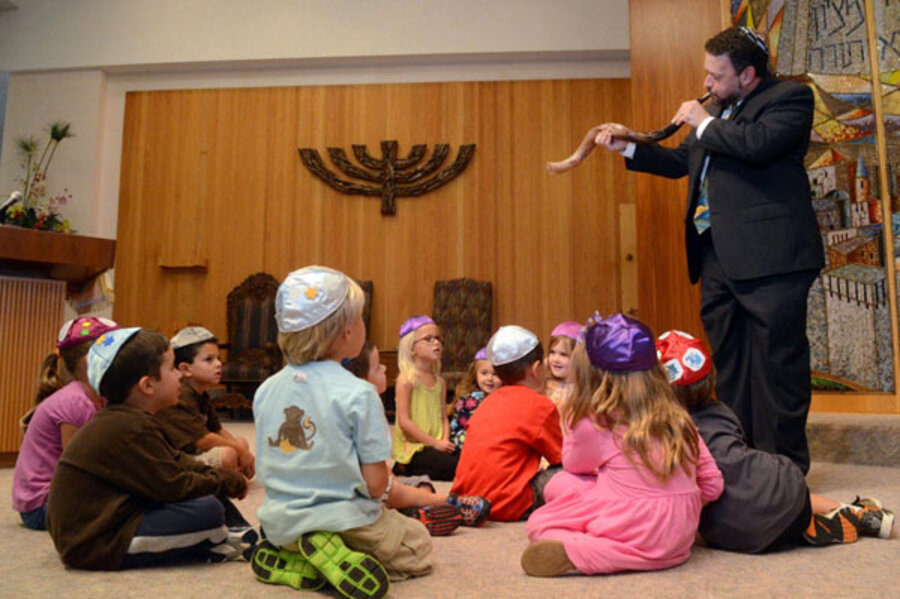Jewish holidays: How not to scare the kids with the imagery
Loading...
I’ve been thinking a lot about color lately. Or more to the point, the presence and absence of light that make up white and black. I think all this consideration of color reflects the fact that I’ve been vacillating somewhere between hope and despair this High Holiday season.
It’s a state of mind that squarely puts me in the middle of the gray zone. That’s Adam’s term for these 10 intermittent days between Rosh Hashana and Yom Kippur. I clearly remember when he first mentioned the gray zone. It was fifth grade and he had just learned about the Ten Days of Awe – the days between the High Holidays. He didn’t see anything awesome about being suspended in doubt and self-criticism.
RELATED: Top 5 bullying myths - What you don't know about bullying
Which leads me to the conundrum at the heart of the gray zone discussions I had with him. How do you explain the High Holidays to kids without scaring the living daylights out of them? Just the images alone send me into black hibernation. No light, no consciousness. Let God add and erase names in the Book of Life without my awareness.
But that’s not exactly good role modeling. If there’s anything that should be deleted it’s our understanding of the Sunday School God that dips a feathered quill into ink and enters names as part of some macabre accounting. The God I first became acquainted with had a flowing white beard. When I was a little older, he looked exactly like my Uncle Mac of the booming voice and the rosy cheeks. Uncle Mac was God on earth.
I imagine that most kids cope with God as the ultimate abstraction by pretending that He’s some version of their own Uncle Mac. In this patch of gray that Adam constructed as a little boy, it followed that God is also gray. But it’s impossible to see anything through the fog that shrouds Him. Also, note how useless it is to shine headlights in the fog. The light reflects back, illuminating nothing. Maybe that’s the hard-edged perspective of an adult.
I found a lovely children’s book called "Because Nothing Looks Like God," by Rabbi Lawrence Kushner and Karen Kushner, that breathes life into some of my grown-up jadedness. God is in the details like a birthday cake, the band-aid that fixes a cut. Ultimately, “God looks like nothing. And nothing looks like God.” The authors challenge children to think about how many things we can’t see like the wind, or the sun drying or the joyous moments of a day at the beach. I ‘d also ask kids to think about what love does and does not look like.
But how do you explain God to a teenager whose earliest memories are singed with images of burning towers? What do you say to your children after you’ve been pulled over by airport security for a more thorough search? You’re part of the danger in this very dangerous world? Or let’s turn to the more mundane. You work hard and you study hard and still that A or that role in the play eludes you. Does God have more important matters to attend to than the disappointments in your life? Or is God simply too distracted these days to care about your problems?
“First world problems,” shrugs Adam the now-jaded teenager. That’s his default position to deal with his disillusionment.
Maybe I’m taking all of this too literally. Children grow into more sophisticated thinkers, leaving a parent like me stuck in the concreteness of pshat – the Jewish term for biblical literalism. I envy my teens who, these days, are in the thick of drash – extracting meaning from the subtext of a story or a new situation. Maybe my time in the gray zone is best spent listening to my kids explain life to me.
This is also the time of year when we read Leviticus 18 on the afternoon of Yom Kippur – a verse that many take in as pshat to condemn gay marriage. At first glance it seems odd to be worrying about forbidden unions on a day when the gates of heaven are clanging shut. (More concreteness.) But who knew that the gray zone could be conducive to a personal and loving discussion on sex education with your kids. Who shall live and who shall die can be transformed into a celebration of whom we love. Who will we love better and more thoughtfully in this New Year?
RELATED: Are you a 'Helicopter Parent?' take our QUIZ!
The Ba’al Shem Tov, the father of the Hasidic movement in the 18th century, said “there are many halls in the king’s palace and intricate keys to all the doors. But the master key to God’s house is a broken heart.” That leads up to one of my favorite sayings in the Talmud: “There is nothing more whole than a broken heart.” And there’s no better place to learn that than in the space that Adam, in his little boy wisdom, once dubbed the gray zone.
The Christian Science Monitor has assembled a diverse group of the best family and parenting bloggers out there. Our contributing and guest bloggers are not employed or directed by the Monitor, and the views expressed are the bloggers' own, as is responsibility for the content of their blogs. Judy Bolton-Fasman blogs at The Judy Chronicles.






